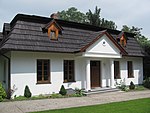Drwinka
Drwinka is a river, the right bank tributary of the Vistula with a length of 31.05 km (19 mi).Drwinka flows in the Wieliczka and Bochnia Counties of Lesser Poland Voivodeship from sources near Niepołomice to the mouth in Świniary, 133.5 km (83 km) into the Vistula River. Among its tributaries are streams and ditches from Niepołomice Forest, Wilczy Forest and from near Gawłówek. The southeastern part of its catchment basin is situated in the sandy area of the Vistula valley, filled mainly with quaternary river sediments covered with loess and sandstones of a dozen or so feet. Here the river passes through the Niepołomice Forest, dividing it into two different flora complexes. The overall quality assessment of the Drwinka river waters at its estuary in physico-chemical, hydrobiological and bacteriological terms corresponds to Class I or Class II standards. Water in Drwinka does not show signs of eutrophication.
Excerpt from the Wikipedia article Drwinka (License: CC BY-SA 3.0, Authors).Drwinka
79, gmina Koszyce
Geographical coordinates (GPS) Address Nearby Places Show on map
Geographical coordinates (GPS)
| Latitude | Longitude |
|---|---|
| N 50.133554 ° | E 20.49385 ° |
Address
Ringstand 58c
79
32-130 gmina Koszyce
Lesser Poland Voivodeship, Poland
Open on Google Maps



